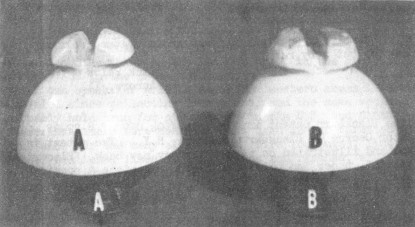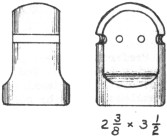Porcelain Insulator News
by Jack H. Tod
Reprinted from "INSULATORS - Crown Jewels of the Wire", April 1978, page 17
Bob Reyburn (Ontario, Cal.) recently sent the photo below of two Imperial
insulators in his collection. The Item A is the normal U-935 Imperial, but the
Item B is a top-rest one that matches U-746 which is the proverbial
"Redlands"
style made by other companies in later years.

I can't recall for sure whether anyone has ever reported a U-746 by Imperial
Porcelain Works before, so this may be a new report on that. The manufacturing date
on Bob's specimen isn't legible, but it certainly would be later than the
1897 to 1898 dates that appear on the U-935 specimens.
What I said in the Feb
1977 CJ for the Redlands insulator still mostly holds, except that we now have
an Imperial U-746 that matches the Redlands made by other companies in later
years. The Imperial U-935 was made before the so-called Redlands was developed,
and it appears now that the U-746 could have stemmed from this earlier design. I
can't see that the U-746 was all that different from their earlier U-935, but it
was the U-746 that was exactly copied later on by other companies and came to be
known as the "Redlands" insulator by the industry.
Jack

Dear Jack:
I read with much interest your answer to the letter in the
January 1978 column (page 23) concerning holes in insulator crowns. Enclosed is
a copy of a page from the March 1971 OBX magazine showing a peculiar pin type
owned by Arch Poeppel and which is the so-called "Blackburn's Patent".
This appears to be concerned with these holes. I was going to write to the
Patent Office to get the patent, but I thought that you might have ready access
to it.
You see, I collect glass CD-102's, and I have been going through my old
back issues of magazines, making copies of all relevant material for a
scrapbook. This is how I cane across these data. I most say, though, that
porcelain interests me more and more, and I've been thinking of getting into
Locke ponies.
Oh, your new book (Electrical Porcelain) is incredible. It's an example of what all writers of insulator books may aspire to, but very rarely
equal.
Dick Bales
Aurora, Ill.
- - - - - - - - - -
Dear Dick:
The Blackburn patent involved is #504,059 of 8-29-93, inventor George W. Blackburn, Palmyra, N.Y. The patent is listed and illustrated on page
129 of my new book, "Electrical Porcelain", under Tod Class 4 (Cleats,
one-piece & specials). It isn't listed under the several pin type classes
because the patent illustration used was a form of cleat.
Since Poeppel's aqua
glass specimen is marked with the 8-29-93 date, and since I know of no other
Blackburn patent for that date, I think patent #504,059 is the pertinent one.
The principle involved is a snap-type bail wire system for holding the
conductor, and the two holes in the flat surface are to accommodate the pivots of
the bail wire parts Note that the holes in the specimen are only 1/8" deep.
There are a number of patented bail-wire systems and other gadgets to replace
tie wires, but this is the only one I know of which requires pivot holes in the
insulator itself.
Jack
Dear Jack:
I was just wondering if you could give me some information on
the old white porcelain Thomas (made in USA) two-piece tree insulators, such as
value, age, etc. I have a number of these, both small and large size.
It seems
that such kinds of insulators are not easy to find; at least this is the situation
up in this region.
About 30 years ago many were in use on the old forestry telephone lines to
fire lookout towers. Now most of these lines are down, and few insulators can be
found. However, during the past summer I did find a number, all in the best of
shape. I cannot recall of ever seeing them used on other phone lines in the area
in the past, nor do other people seem to know of them either.
I have various
insulators from a number of countries and have a very large collection of many
kinds of telephones. Collecting such items has been an interesting hobby for me,
but space for display is indeed a problem too.
I always read Porcelain Insulator
News in Insulators magazine and must say that it is most interesting and
informative, so please keep up the good work.
Wayne Junop
Palmer Rapids, Ont. KOJ 2EO
- - - - - - - - - -
Dear Wayne:
Forestry insulators such as these have been used on many lines
since the 1890's and are probably still being installed in some applications.
Host companies manufactured them if they made electrical porcelain dry press
insulators, but Thomas seemed to make them for the longest time, in the greatest
variety and in the greatest quantity.
I can speak for Arizona and other western
areas I've traveled since collecting insulators, and the sane would probably hold
true for other areas in the U.S. and Canada. These insulators were nearly always
used in our forested mountains for the many alarm lines (fire lookouts), lines
to ranger stations, lines to small towns and ranches, etc. Many such lines were
installed in the 1930's. Most of the Forest Service lines were abandoned in the 1950's with a switchover to radio
communications, and you can see these white "doughnuts"
hanging on trees all along many of the roads in our pine mountains.
Although
many collectors have a shelf for varieties of forestry insulators, their trade
value is relatively low due to easy availability. Anyone living in or near
mountain areas can get all they want from the abandoned lines -- the wires long
gone but the insulators still hanging there on the trees. I've had them on sell
lists and at show tables for $.25 to $.50 with few takers, but anyone specializing in
these would gladly pay a nominal dollar or so to get a new variety or marking
they wanted. On many insulators, it's the fun of collecting, and to heck with
dollar values. That's the case here too.
Jack

Dear Jack:
I have a chocolate brown wireholder, 2-1/2" diameter by 3"
long, with a recess-embossed G. E. Co. marking (as shown at the right). The
wireholder shape is the same as the SEYLER one shown in the upper left corner of
page 130 of Gerald Brown's 2nd Edition. The GE marking is in the same position
as the SEYLER marking, and there is a partially illegible part number on the
other side in the same position.

I also have a U-310 pin type with a Franklin marking as I've sketched here
(at the right) and illustrated with the enclosed foil impression. I can't tell
if the vertical bar above the FP is meant to be a numeral 1 or a letter I, or
something else. The sides of the bar are slightly irregular but probably not
intentionally.
If these markings were reported earlier, I missed them.
Fred A. Hildebrand
Lakewood, Colo.
- - - - - - - - -
Dear Fred:
Nope, both are new reports.
The monogram-GE must be something rather modern for porcelain markings. Most
of their older porcelain insulators are just marked "G. E. Co.",
usually with an accompanying catalog number, and sometimes with
"U.S.A.".
I have no idea of the meaning of the code marking above the normal FP in the
Franklin handstamp. I've seen a number of U-310 with the FP stamp, but never
this version.
Jack

Dear Jack:
Last week a very early building was demolished in town (progress I guess!!).
Being a scrounger of sorts, I did some fast looking and picked up a lot of
porcelain nail knobs made by Smith & Stone (Georgetown, Ont.). I'm taking
the pleasure of sending a few to you.
Also found a few marked HESS CO. (or HESSCO). Do you have any info on this
one?
Where the wires had to go thru a beam, a lot of porcelain tubes were used.
Some were marked "G" on the head, and others "C. G. E.".
Don Schuknecht
Guelph, Ontario, Canada
- - - - - - - - - -
Dear Don:
Many thanks for the look-see at these new specimens, and which will also add
to my collection of such items.
The HESS CO. draws a blank with me, and hopefully some of our Canadian
readers will send the answer to us.
The "G" marking is still our porcelain insulator mystery marking.
I'm guessing the C.G.E. marking is for Canadian General Electric Co., Toronto,
Ontario.
Jack
Dear Jack:
I have spent many quiet and happy hours here in my study room since I
received your "Porcelain Insulators", blue book, second edition.
Three-fourths of my insulators are glass, but a year ago, in a small neighboring
town of 2,000 population, the power company moved to a new location and dumped
their old power cables in the town land fill. When I heard of this, and by the
time I got there, the big bulldozer had already buried and crushed most of them.
However, I still got home with about 40; about 15 or so are real goodies on
which I'm still doing a lot of research work. I have been collecting for 4
years, but the past year has been spent more on research and study.
I look forward every month in Crown Jewels for your very informative
section on porcelains. To me, the challenge is much greater than in glass
insulators. Anyway, the excitement of any new find is terrific whether in
porcelain or glass.
Would like to mention that I was on local TV news January 1st with my
insulators, and next week my story should be in the Oklahoma city paper.
Enclosed is the story in our local newspaper. I an trying to get a club started
in Southwestern Oklahoma, and I thought a little publicity might help some. I
have had so many calls and letters since January 1st I guess I will have open
house in the very near future. My story in a leading national family magazine
will be out in May or June.
Carolyn Theesen
203 N. 40th
Lawton, OK 73505
- - - - - - - - - -
No lack of enthusiasm on Carolyn's part. You should have seen the full-page
newspaper story, pictures and all. The hobby is growing again, but a little
publicity certainly will spur things on. Anyone in the area should contact
Carolyn about interest in forming a local club. In Arizona, we found collectors
so scattered that our try at a "club" ended up in annual get-togethers
with an informal show and swap session. More recently, we've had some
round-robin meetings at various collectors' homes to see the collections and
swap tall tales, Needless to say, these sessions rapidly created many traders
for those of us who also collect empty beer cans!

I recently had a call from Charlie Artman (a bottle collector in
Massachusetts), and he related how he found a U-982 "Bennington" near
Norton, Massachusetts. He was digging for bottles at a very old building that
had just been torn down. Naturally he was very excited over the lucky find. To
my knowledge, this is the second known specimen of a U-982 threadless.
| 